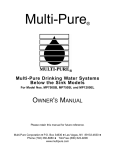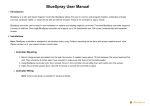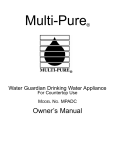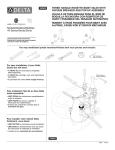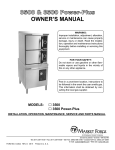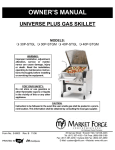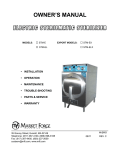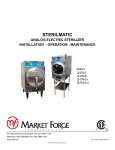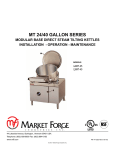Download Market Forge Industries MT-60 Owner`s manual
Transcript
OWNER’S MANUAL MODULAR TILTING KETTLES MODELS:□ MT-25 □ MT-40 □ MT-60 INSTALLATION, OPERATION, MAINTENANCE, SERVICE AND PARTS Form Number: S-2110 PRINTED IN U.S.A. Rev: C 06/12 35 Garvey Street • Everett • MA • 02149 Tel: (617) 387-47100 • Toll Free: (866) 698-3188 • Fax: (617) 387-4456 • Outside MA Fax: (800) 227-2659 E-Mail: [email protected] • Website: w w w . m f i i . c o m TABLE OF CONTENTS INTRODUCTION DESCRIPTION........................................................................................................................................................ 1 25-, 40-, & 60-GALLON TILTING KETTLES........................................................................................................... 1 SERVICE................................................................................................................................................................. 1 SERVICE CONNECTIONS..................................................................................................................................... 2 OPERATION OPERATING CONTROLS & INDICATORS............................................................................................................ 3 OPERATING PROCEDURE 25-, 40- & 60-GALLON KETTLES............................................................................. 3 CLEANING PROCEDURE...................................................................................................................................... 3 CLEANING 25-, 40- & 60-GALLON KETTLES....................................................................................................... 3 OPERATING CONTROLS....................................................................................................................................... 4 PAN SUPPORT MOUNTING TILTING KETTLES................................................................................................... 5 MAINTENANCE GENERAL............................................................................................................................................................... 6 PREVENTIVE MAINTENANCE............................................................................................................................... 6 CLEANING.............................................................................................................................................................. 6 TILTING MECHANISM LUBRICATION................................................................................................................... 6 REPAIR & REPLACEMENT.................................................................................................................................... 6 LID COUNTERBALANCE ADJUSTMENT.............................................................................................................. 6 CABINET EXTERIOR REMOVAL........................................................................................................................... 6 DRAW OFF VALVE REPAIR................................................................................................................................... 7 COMMON LEAK REPAIRS..................................................................................................................................... 7 VALVE SEAT LAPPING........................................................................................................................................... 7 TILTING MECHANISM REPAIR.............................................................................................................................. 7 SAGINAW SCREW ASSEMBLY REMOVAL........................................................................................................... 7 GENERAL INSPECTION & CLEANING.................................................................................................................. 7 BALL NUT DISASSEMBLY..................................................................................................................................... 7 BALL NUT INSPECTION........................................................................................................................................ 8 BALL NUT REASSEMBLY & BEARING REPLACEMENT...................................................................................... 9 CRANK SLEEVE REPLACEMENT......................................................................................................................... 9 BRAKE MECHANISM DISASSEMBLY & REPAIR.................................................................................................. 9 ILLUSTRATED PARTS GENERAL.............................................................................................................................................................. 10 ORDERING INFORMATION.................................................................................................................................. 10 FIG 4 25- & 40-GALLON TILTING KETTLES......................................................................................................... 11 FIG 5 TILTING MECHANISM FOR 25- & 40-GALLON KETTLES......................................................................... 12 FIG 6 60-GALLON TILTING KETTLES.................................................................................................................. 13 FIG 7 TILTING MECHANISM FOR 60-GALLON KETTLES................................................................................... 14 FIG 8 HINGE & LID ASSEMBLY........................................................................................................................... 15 FIG 9 STEAM SUPPLY VALVE ............................................................................................................................. 16 FIG 10 SWING DRAIN........................................................................................................................................... 16 FIG 11 DRAW OFF VALVE..................................................................................................................................... 17 FIG 12 STEAM TRAP............................................................................................................................................. 17 FIG 13 F AUCET & SPOUT ASSEMBLY, 25-, 40- & 60-GALLON KETTLES (NEWER VERSION)........................ 18 FIG 14 F AUCET & SPOUT ASSEMBLY, 25-, 40- & 60-GALLON KETTLES (OLDER VERSION)......................... 19 FIG 15 CABINET BASE (NEWER VERSION)....................................................................................................... 20 FIG 16 24” CABINET (OLDER VERSION)............................................................................................................. 21 FIG 17 36” CABINET (OLDER VERSION)............................................................................................................. 22 FIG 18 48” CABINET (OLDER VERSION)............................................................................................................. 23 FIG 19 ACCESSORIES FOR STEAM JACKETED KETTLES............................................................................... 24 INTRODUCTION This service and parts manual contains general information, operation, and maintenance information for Market Forge modular kettles. A parts list is included in which each replaceable part is identified and shown in an accompanying drawing. Accessories for use with the kettles are also described. SERVICE Modular kettles are exceptionally reliable and durable cooking equipment requiring a minimum of service other than routine cleaning and preventive methods explained in the maintenance section. Should repairs be required, a network of authorized service agencies is available to assist with prompt service. DESCRIPTION Market Forge tilting steam jacketed kettles of three capacities, each mounted in a modular stainless steel cabinet. Double wall construction around the lower half of the kettle forms a surrounding chamber into which steam is introduced as a source of heat for cooking. A current Directory of Authorized Service Agencies may be obtained by contacting: Customer Service Department, Market Forge 35 Garvey Street, Everett, Massachusetts 02149 Telephone: (617) 387-41 00, (866) 698-3188 [email protected], www.mfii.com Steam input plumbing is equipped with a manual control valve. Condensate is removed through a steam trap connecting with the kettle drain plumbing assembly. A swivel spout, hot-cold combination faucet provides a source of water for addition to the kettle for cooking and cleaning. The model and serial numbers must be referenced when corresponding with Market Forge. An optional 12” spacer unit with faucet and sink may be used instead of the standard built-in faucet. The data plate containing model and serial numbers pertaining to the equipment is located inside the cabinet door on the right vertical frame member. 25-, 40-, & 60-Gallon Tilting Kettles Large capacity kettles are fitted with heavy duty tilting mechanisms operated by removable hand crank. Each model is equipped with a pan support which maintains continuous alignment of serving pans under the pouring spout at all levels of kettle elevation. Counterbalanced hinged lids cover the kettles in the lowered position. All are plumbed for direct connection to a remote steam source. An optional cold water circuit to the steam jacket is available for use with all models for quick cooling of foods after cooking. Applicable model designation include: MT-25 A 25-gallon (94 liter) capacity tilting kettle mounted in a 36” (914mm) wide cabinet base. MT-40 A 40-gallon (152 liter) capacity tilting kettle mounted in a 36” (914mm) wide cabinet base. MT-60 A 60-gallon (228 liter) capacity tilting kettle mounted in a 48” (1219mm) wide cabinet base. 1 INTRODUCTION SERVICE CONNECTIONS Direct Connected S Steam Supply - 3/4” (19mm) NPT, 15 P. S.I (1.0 kg/cm2) minimum; 30 P.S.I (2.1 kg/cm2) maximum. HW Hot Water - 3/8” (10mm) OD tubing to hot water for kettle fill faucet. CW Cold Water - 3/8” (10mm) OD tubing to cold water for kettle fill faucet. D Drain - Pipe full 2” NPT (51mm) to flush floor drain. Do not make solid connection to drain. CR* Condensate Return - 1/2” I.P.S. (13mm) connection for condensate return from kettle when specified. MT-25 MT-40 EC* Electrical Controls - 115 volts AC, 60 Hz, 40 watts, 1/2” (13mm) conduit connection or equivalent. Use wire suitable for at least 90OC. Draws less than 1 Amp with power lift. * Optional MT-60 NOTES: Pressure-reducing valve is required if incoming pressure exceeds 30 PSI (2.1 kg/cm2). Recess area for kettle draw-off (dotted line) must be kept free of all piping and connections. PVC and CPVC pipe are not acceptable materials for drains. Separate height for 25-, 40-, and 60-gallon kettles. 2 OPERATION 3427) can be used to support pan during filling. OPERATING CONTROLS & INDICATORS All of the controls required to operate the kettles are listed in table on page 4, together with an explanation of location and a short functional description. 12. Remove food from tilting kettles. With Pan Support mounted (see section pan support mounting tilting kettles, on page 5), food pan in support, and Crank installed in front of cabinet, turn crank clockwise to elevate kettle for pouring. (Tilting mechanism is infinitely adjustable and non-coasting in kettle elevation and lowering). Liquid foods may also be removed by use of the Draw-Off Valve as explained in step 11 for stationary kettles. OPERATING PROCEDURE 25- 40- & 60-GALLON KETTLES All kettles must be supplied with steam from a generator which is remotely located. Consult steam generator information or instruction plate and complete all start-up instructions. Proceed with kettle operating procedure as follows: 1. Check pressure gauge of steam supply source to insure steam input is at 15 PSI (1.0 kg/cm2). For direct connected steam, turn on external steam supply valve. 13. Complete cleaning procedures (See section below, cleaning 25-, 40- & 60-gallon kettles). CLEANING PROCEDURE As with cleaning food soil from any cookware, an important part of kettle cleaning is to prevent foods from drying on. For this reason cleaning should be completed immediately after cooked foods are removed. If time can not be allotted for immediate complete cleaning the kettle should be soaked by filling it with warm detergent water solution. 2. Check that Draw-Off Valve is tightly closed. 3. Lift kettle lid and place either a Solid or Perforated Drain Disc over the drain inside kettle. Use solid disc to retain liquids; perforated to strain liquids from food. 4. Load kettle with foods to be cooked. 2.4.2 Cleaning 25-, 40- & 60-Gallon KETTLES 1. Wash the kettle with a long handled nylon bristle kettle brush (Part No. 10-5308). 5. Add water for cooking by swinging spout over kettle and using Combination Faucet. 2. Empty wash water by opening Draw-Off Valve over Swing Drain. 6. Turn Steam Control Valve to full counter-clockwise position to heat kettle content to an initial rapid boil. 3. Remove Drain Disc (solid or perforated) from inside kettle and clean. 7. Adjust subsequent cooking temperature by turning Steam Control Valve. Turn clockwise to reduce heat and counter-clockwise to increase. 4. Rinse kettle by flushing with hot water from the Swivel Spout. 8. Close Steam Control Valve (full clockwise position) when cooking is complete. 5. Loosen hex nut on Draw-Off Valve and carefully remove all parts. Clean and reassemble. (See figure 11, on page 17). CAUTION: Food must either be removed from the kettle immediately or cooled by a kettle jacket cooling system to prevent over cooking. 6. Rotate Swing Drain to left and push up off drain assembly. Clean drain and screen. Reassemble on kettle. 9. For Chill Kettles use an external water source to flood kettle interior with cold water until all hot cooking water flow over kettle rim into sink. 10. For kettles equipped with optional cold water source water jacket cooling system open the Jacket Cold Water Valve (full counter-clockwise position) and leave open until food temperature is sufficiently lowered. 11. Remove food from stationary kettles. For liquids rotate the Swing Drain to the side and fill food containers from the Draw-Off Valve. For solids which will not pass through the valve, use a ladle. An optional stationary pan holder (Part No. 903 OPERATION OPERATING CONTROLS NAME LOCATION FUNCTION Kettle Handle Kettle Rim Grasped to tilt kettle for pouring. Steam Control Valve Top, Left Side Controls steam flow to kettle jacket. Combination Faucet Top, Right Side Controls hot and cold water to swivel spout. Swivel Spout Top, Beside Kettle Direct water into kettle. Turns away for kettle tilting. Sink with Splash Shield Top, Front Accepts kettle drainage. Shield forward protects operator from splashing, reverses for storage. Lid Handle On Lid Grasped to open and close kettle lid. Perforated Drain Disc Inside Kettle on Drain Covers drain to strain liquids when draw-off is open. Solid Drain Disc (Optional) Inside Kettle on Drain Covers drain to block it off. Crank (Tilting Kettles) Front, Right Side Raises and lowers tilting kettles for pouring. Stow on back of cabinet door when not in use. Steam Control Valve Top, Right Side Controls steam flow to kettle jacket. Draw-Off Valve Inside Cabinet, Left Controls drainage of kettle. Swing Drain with Strainer Inside Cabinet, Left Accepts drainage from draw-off valve. Swings to side to allow serving containers to be placed under draw-off valve. Combination Faucet with Swivel Spout Top, Right Side Control hot and cold water to kettle interior. Turns away for kettle tilting and access. Cold Water Valve (Chill Kettles and Others with Optional Jacket Cooling Systems) Right, Front Controls flow of water to steam jacket for rapid cooling after cooking. Basin Waste Drain (Chill Kettles Only) Left, Top Accepts kettle overflow in chill kettle sink. Pan Support (Tilting Kettles Only) Front, Top Holds serving pan in alignment with kettles for pouring (see section pan support mounting tilting kettles, on page 5) 4 OPERATION Pan Support Mounting Tilting Kettles For convenience during cooking, the pan support need not be installed until needed for removing food from the kettles. To Insure correct operation and to prevent spills the support must be securely installed as shown in Figure 1 below and as explained below: 1. Hold the pan support in front of the upright as shown at A. 3. Rotate the pan support upward (C) and engage the slotted ends of the support links in the studs at the base of each support upright as in D. The removal procedure is the reverse of installation with the exception that in step 2 support upright springs must be pushed out to release the support from studs. 2. Place the stud of the left-hand support upright into the hole in the left side of the pan support. Then push the right side of the support in until it engages the spring loaded pin of the right-hand support upright, shown at B. Figure 1 Mounting Pan Support 5 MAINTENANCE tle itself or the steam supply which heats the kettle. While mechanical problems are obvious faults of the kettle, any deficiencies in volume and pressure of steam should be traced to the steam generator and the cause determined. WARNING: DO NOT HOSE DOWN UNIT AS IT CONTAINS ELECTRICAL COMPONENTS. GENERAL This section contains both preventive and corrective maintenance information. Preventive maintenance may be performed by maintenance personnel at the establishment in which the kettle is installed. Steam input requirements are listed in Appendix A, Modular Kettle Steam Requirements. Additional information may be found in separate service publications for steam generators. It is recommended that user personnel never attempt to make repairs or replacements to the equipment without the assistance of authorized service. Assistance in service methods or, a current Directory of Authorized Service Agencies may be obtained from Market Forge. (See service section on page 1). Lid Counterbalance Adjustment The kettle lid is equipped with a torsion spring counterbalance device to assist in lid lifting and to prevent slamming. The device is shown assembled in the Figure 2 below and exploded in Figure 8, on page 15. If lid slams closed when handle is released, spring tension should be increased. If lid lifts up or refuses to remain down on kettle, tension should be reduced. To adjust spring tension proceed as follows: 1. Loosen 1/4” jam nut. PREVENTIVE MAINTENANCE The most important preventive maintenance operation on the steam jacketed kettle is the cleaning procedure after each use described on page 3. Additional preventive maintenance operations are presented in this section. 2. Adjust spring tension by turning 1/4” hex head cap screw. Tighten to increase tension; loosen to reduce tension. Cleaning A policy should be faithfully observed of completing, by the end of each day’s operation, all kettle cleaning procedures explained in cleaning procedure section on page 3. 3. Operate lid several times, repeating, step 2 until desired operation is obtained. 4. Hold hex head screw firmly in position and tighten jam nut to lock adjustment. In addition, cabinet doors, top, fixtures, kettle lid, etc., should be washed and rinsed to remove all food spills. For Chill Kettles, extra care must be given to cleaning the sink surrounding the kettle. Pan support should be removed as described in pan support mounting tilting kettles on page 5. Tilting Mechanism Lubrication Lubrication of the tilting mechanism of 25-, 40- and 60-gallon tilting kettles is the only required preventive maintenance other than daily cleaning. Inspect the screw of the tilting mechanism annually for adequate lubrication. Should screw appear “dry” apply a good grade of ball bearing grease directly on the threads so that the threads appear to be barely damp. If mechanism fails to run smoothly (see tilting mechanism repair on page 7). Figure 2 Lid Counterbalance Adjustment Cabinet Exterior Removal Side and rear panels of all cabinets in which kettles are mounted are easily removed without the use of tools. Each panel is grasped at the bottom edge and pulled out sharply to release it from the panel mounting brackets Shown in Figure 8, on page 15. REPAIR & REPLACEMENT In the event that the kettle fails to operate correctly, the difficulty should first be isolated to either the ket6 MAINTENANCE mechanism repairs which follow. Replacement is completed by pushing panel up under cabinet top and pressing in at the bottom until panel mounting brackets are engaged. Doors may be removed to improve access to cabinet interior for repairs as shown In Figure 16 on page 21. Saginaw Screw Assembly Removal The assembly is removed with the kettle in the lowered position. Proceed as follows: 1. Remove the two bolts (8) which hold the ball nut assembly in the screw lever (7). The two flat head screws (10) and nuts (12) holding cabinet hinge (11) are removed and the door lifted out. When doors are remounted the final tightened position of hinge (11) determines the alignment of the door and must be set with care. 2. Remove the two 5/16” hex head cap screws (13) which fasten the screw housing (14) to the cabinet frame (not shown). 3. Lift screw assembly from the cabinet. Proceed in reverse order to replace the assembly. Draw-OFF Valve Repair An exploded view of the draw-off valve is shown in Figure 11 on page 17. All parts are replaceable. General Inspection and Cleaning The screw assembly should run smoothly throughout the entire stroke. If operation is not uniform remove the screw assembly (refer to saginaw screw assembly removal above) and proceed as follows: 1. Inspect screw shaft for signs of accumulation of foreign matter in the ball grooves. Common Leak Repairs To repair a valve leak, the source must first be determined. Leaks from around the valve stem are corrected by replacing the rubber “0” ring (5) .Dripping from the valve outlet which occurs with the valve tightly closed indicates faulty seating of the valve disc (part of 6) against the valve seat. Dripping is often corrected by cleaning residue from disc and seat using very fine emery. 2. Using cleaning fluid or solvent remove dirt from ball grooves. Be sure to flush the ball nut assembly thoroughly. 3. Cycle the ball nut along the screw shaft several times. Wipe with a dry lint less cloth and lubricate immediately. (refer to tilting mechanism lubrication on page 6). Valve Seat Lapping Should either the disc (part of 6), or seat be found damaged it is necessary to either replace the entire valve or perform the lapping procedure as follows: 1. Disassemble the valve and clean both the disc and the valve seat. 4. If assembly continues to operate erratically after cleaning disassemble and inspect the ball nut assembly. 2. Attach the handle (2) to the stem with the valve bonnet (4) removed. Ball Nut Disassembly The Saginaw Screw is a ball bearing screw power transmission device which converts the turning motion applied by the hand crank ( 1) into bi-directional force against the screw lever (7). The frictionless “easy” transfer results from the use of bearing balls circulated be- tween the screw and nut in concave helical grooves. As the screw rotates inside the nut, the bearing balls are directed from one end and carried by a ball guide to the opposite end of the ball nut. Figure 3 on page 8 shows a cut-away view of the ball nut. 3. Apply a good grade of fine lapping compound to the disc and insert it into the valve to make light contact against the seat. 4. Rotate the stem disc against the seat by turning the handle, allowing the stem to wobble in the space the bonnet would normally occupy. Continue with light pressure until compound dries. 5. Reassemble and test for leaks with valve closed. If dripping occurs repeat the lapping procedure as many times as required to obtain a watertight seal. Nut disassembly requires extreme care in handling to avoid loss of bearing balls and other small parts. The Saginaw Screw must be removed from the kettle (refer to saginaw screw assembly removal above) and the procedure completed over a clean work surface. A small clean container and clean cloth are required. 1. Place a clean cloth on the work surface with edges gathered to form a pocket to retain the bearing Tilting Mechanism Repair Tilting kettles are equipped with tilting mechanisms shown in Figure 5 on page 12 for 25- and 40- gallon kettles and Figure 7 on page 14 for 60-gallon kettles. Though both .utilize the same screw assembly (2) , only Figure 5 on page 12 includes brake disassembly detail and serves as the reference view for tilting 7 MAINTENANCE balls. 2. Place the Ball Nut Assembly over the pocket and remove the two Clamp Screws and the Guide Clamp. 3. Remove both halves of the guide simultaneously to prevent distortion of either half. 4. Catch all the Balls on the cloth by slowly rotating the Ball Nut on the screw. Place all balls in a small container. Take an accurate ball count and record. CAUTION Every bearing ball is required for reassembly. Exercise care in handling to avoid loss. 5. Remove the stop collar (5) held by set screw (3) at the free end of the screw shown in Figure 4-8. 6. Slide the Ball Nut off the free end of the screw. Ball Nut Inspection Disassembly of the ball nut must be completed to permit inspection (Refer to ball nut disassembly on page 7). A Ball Bearing Replacement Kit containing bearing balls and ball guide is available from Market Forge parts distributors. Should the ball nut show excessive wear I the entire Saginaw Screw assembly must be replaced. Inspect components for wear points: a. Balls. Check a random sample of 20 balls for signs of scuffing or fish scaling. Diameter variation between balls and true roundness of each one must be within .0001 inch. Balls which fail to meet these requirements should be replaced using the Ball Bearing Replacement Kit. b. Guide. Inspect the pick-up fingers which consist of short extensions at the end of each half guide. Minor burrs can be removed and the guide reused. If a ball impression appears on the finger tips or the halves were distorted during removal, the guide must be replaced. c. Ball Nut. Inspect the internal threads of the ball nut for signs of excessive wear, pitting, gouges, corrosion or spotting in the ball groove area. If these flaws are detected, the entire Saginaw Screw assembly should be replaced. Figure 3 Ball Nut Assembly 8 MAINTENANCE Ball Nut Inspection Disassembly of the ball nut must be completed to permit inspection (refer to ball nut disassembly on page 7). A Ball Bearing Replacement Kit containing bearing balls and ball guide is available from Market Forge parts distributors. Should the ball nut show excessive wear I the entire Saginaw Screw assembly must be replaced. Inspect components for wear points: a. Balls. Check a random sample of 20 balls for signs of scuffing or fish scaling. Diameter variation between balls and true roundness of each one must be within .0001 inch. Balls which fail to meet these requirements should be replaced using the Ball Bearing Replacement Kit. screw alignment. 5. Insert bearing balls into the guide opening using slight rotation of the screw to help feed them into the grooves. Place remaining balls into one half of the return guide. NOTE: If a Ball Replacement Kit is to be installed, first count out the same number of new bearing balls as the number of worn balls being replaced. DO NOT try to add extra balls. There must be some free space in the circuit so that balls will roll and not skid. 6. Place a dab of bearing grease at each end of the half return guide to hold balls in place. Place the mating half return guide over the half filled with balls and insert the two ends of the ball guide into the holes in the ball nut. Seat by tapping gently with a rawhide or plastic mallet. b. Guide. Inspect the pick-up fingers which consist of short extensions at the end of each half guide. Minor burrs can be removed and the guide reused. If a ball impression appears on the finger tips or the halves were distorted during removal, the guide must be replaced. 7. Inspect for free movement of the ball nut along the entire stroke. There should be no binding, squeal, or roughness at any point. 8. Place guide clamp in position and secure with clamp screws. c. Ball Nut. Inspect the internal threads of the ball nut for signs of excessive wear, pitting, gouges, corrosion or spalling in the ball groove area. If these flaws are detected, the entire saginaw screw assembly should be replaced. Crank Sleeve Replacement The driving end of the Saginaw Screw (2) is formed into a slotted sleeve which receives the engagement pins of the removable hand crank (1 ). A worn or chipped sleeve which causes the hand crank to slip out of engagement during kettle tilting can be repaired with a Crank Sleeve Replacement Kit (part number 91-2155). Ball Nut Reassembly and Bearing Replacement With the ball nut disassembled (refer to ball nut disassembly on page 7) complete the following reassembly, using either existing bearing balls or substituting a Ball Bearing Replacement Kit (part number 91-1490). 1. Clean all ball nut components with a commercial solvent and dry thoroughly before reassembly. The Saginaw Screw assembly must be removed from the kettle to complete kit installation, (see saginaw screw assembly removal on page 7). The collar (next to the ratchet wheel, Fig. 5 on page 12) is removed by driving out the roll pin which secures it to the screw shaft. The replacement sleeve is slid over the faulty shaft end and fastened with a roll pin. The repair is completed by re-mounting the Saginaw Screw assembly. 2. Slide the ball nut onto the free end of the screw, round nut end first, as shown in Figure 5 on page 12. 3. Replace the stop collar (5) , Figure 5 on page 12. CAUTION: Bearing Balls are retained in the ball nut only when it is mounted on the screw. To prevent the nut from accidentally spinning off the screw the stop collar (or other obstruction) must be placed on the free end. Brake Mechanism Disassembly & Repair The brake mechanism, shown exploded in Figure 48, functions as an anti-coast device for the Saginaw Screw. When the hand crank (1) is turned clockwise (kettle raising) , a ratchet wheel turns freely inside the ratchet stop. Any “free wheeling” counter clockwise screw motion is prevented by engagement of ratchet wheel teeth in the stop and the drag of friction between the shaft collar, and the ratchet wheel face. Additional torque applied by the hand crank, as in kettle 4. Center the ball nut grooves on the shaft grooves by inserting a cylindrical object (a drill bit shank, or other object of same diameter as bearing balls), into the ball nut return circuit hole. Carefully withdraw, taking care not to disturb nut-to9 MAINTENANCE lowering, over-powers the drag and allows the screw to turn with only mild resistance. 2. Slide the ratchet wheel off and inspect for cleanliness. Use fine energy to remove an, build-up of soil or glaze on facings. Failure of the brake mechanism to function as described requires removal of the Saginaw Screw assembly (see saginaw screw assembly removal on page 7) and disassembly of the brake for cleaning. 1. Remove the shaft collar at the crank sleeve end by driving out the roll pin and sliding the collar off. 3. Thoroughly clean all brake mechanism parts of dirt and lubricant. 4. Reassemble the mechanism taking care the ratchet wheel is facing correctly. Replace, the Saginaw Screw assembly in the kettle cabinet. ILLUSTRATED PARTS ORDERING INFORMATION Orders for repair parts should be directed to the nearest authorized parts distributor. general This section contains a complete listing off all replaceable parts of the modular kettles, and of a number of accessories. For the purpose of parts identification, a cut-away drawing is shown for each group of similar kettle models. For a current Market Forge Authorized Parts Distributor List contact: Customer Service Department, Market Forge 35 Garvey Street, Everett, MA 02149 Telephone: (617) 387-4100, (866) 698-3188 [email protected], www.mfii.com Exploded views of sub-assemblies are also provided where greater detail is needed. Tables lists commonly used parts and accessories with a brief description and part number . All orders ‘should contain the Market Forge part number(s) , the part description(s) , and the model and serial numbers of the kettle for which the part(s) is ordered. Each parts list contains the figure index number, the Market Forge part number and an abbreviated description. Care must be exercised in selecting the correct illustrated parts list. Check that kettle size and style coincide with that of equipment to be serviced. 10 ILLUSTRATED PARTS Figure 4 25- and 40-Gallon Tilting Kettles ITEM PART NO. DESCRIPTION 1 -- HINGE AND LID ASSEMBLY, (SEE FIGURE 4-12) 2 -- FAUCET AND SPOUT ASSEMBLY, (SEE FIGURE 4-17 or 4-18) 3 91-1834 SWING DRAIN, (SEE FIGURE 4-14) 4 10-4928 1-1/2” DRAW OFF VALVE, (SEE FIGURE 4-15) 5 10-5242 1/2” ANGLE STEAM VALVE, (SEE FIGURE 4-13) 6 10-3945 CLAMP, CONDENSATE HOSE 7 10-5319 STEAM TRAP WITH HOSE FITTING, (SEE FIGURE 4-16) 8 90-7493 CONDENSATE HOSE, 3/8” ID 36” LG. 9 90-8725 SPLASH GUARD ASSEMBLY 10 90-7495 STEAM HOSE, 3/4” ID 11 10-3916 CLAMP, STEAM HOSE 12 -- 13 90-3788 14 90-3783 PAN SUPPORT UPRIGHT, RIGHT 15 10-1791 MACHINE SCREW, 1/4” x 7/8” LG. 16 10-2403 WASHER, 1/4” 17 10-6784 SPACER, SMALL 18 90-3476 SPACER, LARGE 19 90-0326 PAN SUPPORT, REMOVABLE 20 -- 21 90-3796 36” CABINET, (SS FIGURE 4-19 or 4-22) PAN SUPPORT UPRIGHT, LEFT TILT MECHANISM, (SEE FIGURE 4-8) PAN SUPPORT ADAPTER (OPTIONAL) 11 ILLUSTRATED PARTS Figure 5 Tilting Mechanism for 25- and 40-Gallon Kettles ITEM PART NO. DESCRIPTION 1 90-4037 HAND CRANK 2 90-8728 SAGINAW SCREW ASSEMBLY, COMPLETE 3 10-3026 SET SCREW, ALLEN HEAD, 5/16 - 18 x 5/16” 4 10-2610 ROLL PIN, 3/8” x 2” LG. 5 10-3591 STOP COLLAR 6 90-8754 ‘A’ FRAME 7 90-8755 SCREW LEVER 8 90-8710 BOLT 1/2 - 13, SPECIAL 9 90-9449 LEVER ARM ASSEMBLY 10 91-2155 CRANK SLEEVE REPLACEMENT KIT 11 10-2511 LOCK WASHER, 5/16” 12 10-2405 WASHER, 5/16” 13 10-2042 HEX HEAD CAP SCREW, 5/16 - 18 x 1” 14 90-8757 SCREW HOUSING 15 90-8732 BRAKE MOUNTING BRACKET 16 90-8731 SHOULDER SCREW 17 10-2508 LOCK WASHER, 1/4” 18 10-1907 HEX HEAD CAP SCREW, 1/4 - 20 x 5/8” 19 91-1490 BALL BEARING REPLACEMENT KIT 12 ILLUSTRATED PARTS Figure 6 60-Gallon Tilting Kettle ITEM PART NO. DESCRIPTION 1 91-1834 SWING DRAIN 2 10-3945 CLAMP, CONDENSATE HOSE 3 10-5319 STEAM TRAP WITH HOSE FITTING, SEE FIGURE 4-16) 4 90-7493 CONDENSATE HOSE, 3/8” ID 5 10-4928 1-1/2” DRAW OFF VALVE, (SEE FIGURE 4-15) 6 -- 7 10-5242 1/2” ANGLE STEAM VALVE, (SEE FIGURE 4-13) 8 10-6796 HINGE AND LID ASSEMBLY, (SEE FIGURE 4-12) 9 10-3916 CLAMP, STEAM HOSE 10 91-1977 STEAM HOSE, 3/4” ID 48” CABINET, (SEE FIGURE 4-19 or 4-23) 11 -- 12 91-1839 PAN SUPPORT UPRIGHT, LEFT FAUCET AND SPOUT ASSEMBLY, (SEE FIGURE 4-17 or 4-18) 13 91-1838 PAN SUPPORT UPRIGHT, RIGHT 14 10-1791 MACHINE SCREW, 1/4” x 7/8” LG. 15 10-2403 WASHER, 1/4” 16 10-6784 SPACER, SMALL 17 90-3476 SPACER, LARGE 18 91-1983 PAN SUPPORT, REMOVABLE 19 90-8725 SPLASH GUARD ASSEMBLY 20 -- TILTING MECHANISM, (SEE FIGURE 4-10) 13 ILLUSTRATED PARTS Figure 7 Tilting Mechanism for 60-Gallon Kettles ITEM PART NO. DESCRIPTION 1 90-4037 HAND CRANK 2 90-8728 SAGINAW SCREW ASSEMBLY, COMPLETE 3 91-1959 LEVER ARM ASSEMBLY 4 90-8754 ‘A’ FRAME 5 90-8755 SCREW LEVER 6 10-2310 ROLL PIN, 3/8” x 2” LG. 7 90-8710 BOLT 1/2 - 13, SPECIAL 8 91-1992 SPRING SUPPORT ASSEMBLY 9 10-2746 TENSION SPRING 10 10-3591 STOP COLLAR 11 10-3026 SET SCREW, ALLEN HEAD, 5/16 - 18 x 5/16” 12 91-2155 CRANK SLEEVE REPLACEMENT KIT 13 -- 14 10-2511 LOCK WASHER, 5/16” 15 10-2405 WASHER, 5/16” 16 10-2042 HEX HEAD CAP SCREW, 5/16 - 18 x 1” 17 91-1490 BALL BEARING REPLACEMENT KIT BRAKE AND MOUNTING ASSEMBLY, (SEE FIGURE 4-8) 14 ILLUSTRATED PARTS Figure 8 Hinge and Lid Assembly ITEM PART NO. DESCRIPTION 1 91-1565 ADJUSTMENT PLATE 2 10-1814 HEAD CAP SCREW, 1/4 - 20 x 3/4” 3 10-2336 HEX NUT, 1/4 - 20 4 91-1232 TORSION SPRING COVER 5A 91-1685 TOP BRACKET AND HINGE SUPPORT ASSEMBLY, (25 AND 40 GALLON) 5B 91-1938 TOP BRACKET AND HINGE SUPPORT ASSEMBLY, (60 GALLON) 6 10-2448 NYLON WASHER 7 90-3042 TORSION SPRING RETAINING ROD 8 10-2359 ACORN NUT, 1/4 - 20 9A 91-2012 KETTLE COVER ASSEMBLY, (25 GALLON STATIONARY) 9B 90-7701 KETTLE COVER ASSEMBLY, (25 GALLON TILTING) 9C 90-3949 KETTLE COVER ASSEMBLY, (40 GALLON STATIONARY / TILTING) 9D 91-1963 KETTLE COVER ASSEMBLY, (60 GALLON TILTING) 10 10-2747 TORSION SPRING 11 10-0060 KNOB, PLASTIC 12A 91-1523 ARM, LID, (25, 40 AND 60 GALLON TILTING / 40 AND 60 STATIONARY) 12B 91-2011 ARM, LID, (25 GALLON STATIONARY) 12C 90-0171 ARM, LID, (10 GALLON STATIONARY) 13 10-2355 ACORN NUT 15 ILLUSTRATED PARTS Figure 9 Steam Supply Valve ITEM PART NO. 1 10-0105 DESCRIPTION STEAM VALVE HANDLE 2 10-5247 VALVE DISC 3 10-5242 1/2” ANGLE STEAM CONTROL VALVE Figure 10 Swing Drain ITEM PART NO. DESCRIPTION 1 91-1835 STRAINER, SWING DRAIN 2 91-1834 SWING DRAIN, COMPLETE 16 ILLUSTRATED PARTS Figure 11 Draw-Off Valve ITEM PART NO. DESCRIPTION 1 10-4972 WING NUT 2 10-4971 HANDLE 3 10-4970 HEX NUT 4 10-4968 BONNET 5 10-4969 ‘O’ RING, RUBBER 6 10-4967 STEM 7 10-4928 1-1/2” DRAW OFF VALVE, COMPLETE Figure 12 Steam Trap ITEM PART NO. DESCRIPTION 1A 10-5319 1/2” STEAM TRAP WITH HOSE FITTING, (10, 24, 40 AND 60 GALLON KETTLES) 1B 10-4755 1/2” STEAM TRAP WITH HOSE FITTING, (5 GALLON KETTLES) 2 10-4937 THERMOSTAT, STEAM TRAP 17 ILLUSTRATED PARTS Figure 13 Faucet, and Spout Assembly, 25-, 40-, and 60-Gallon (Newer Version) ITEM PART NO. DESCRIPTION 1 10-5753 SWIVEL SPOUT 2 91-0887 RISER, 15” LG. (25, 40 AND 60 GALLON KETTLES) 3 10-7680 FAUCET 4 08-5467 ADAPTER 18 ILLUSTRATED PARTS Figure 14 Faucet, and Spout Assembly, 25-, 40- and 60-Gallon Kettles (Older Version) ITEM PART NO. DESCRIPTION 1A 10-3766 RISER, (25, 40 AND 60 GALLON KETTLES) 1B 10-3768 RISER, (10 GALLON KETTLES) 2 10-5921 FAUCET 3 10-0990 TAILPIECE, 1/2” OD TUBE 4 10-0991 COUPLING NUT 5 10-0996 STOP VALVE, 3/8” 6 10-1324 UNION, COMPRESSION, 1/2” OD 7 10-5753 SWIVEL SPOUT 8 10-0989 FIBER WASHER 9 10-1100 SWIVEL BODY 19 ILLUSTRATED PARTS 1 2 6 5 3 4 Figure 15 Cabinet Base (Newer Version) ITEM PART NO. 1 08-5894 MARKET FORGE NAMEPLATE LOGO 2 91-5795 HANDLE, FRONT 3 DESCRIPTION PANEL, FRONT ASSEMBLY, 18” 3 98-3992 PANEL, FRONT ASSEMBLY, 24” 3 98-3993 PANEL, FRONT ASSEMBLY, 36” 3 PANEL, FRONT ASSEMBLY, 48” 4 10-0631 LEG, 6” 4 08-5211 LEG, 10” 4 08-5208 LEG, FLANGED 6” 4 08-5206 LEG, 8” 4 10-0326 CASTER, 5” 5 98-3994 PANEL, SIDE ASSEMBLY 6 PANEL, REAR ASSEMBLY, 18” 6 98-3995 PANEL, REAR ASSEMBLY, 24” 6 98-3996 PANEL, REAR ASSEMBLY, 36” 6 PANEL, REAR ASSEMBLY, 48” 20 ILLUSTRATED PARTS Figure 16 24” Cabinet (Older Version) ITEM PART NO. DESCRIPTION 1 90-2657 REAR PANEL, STAINLESS STEEL 2 90-2661 SIDE PANEL, STAINLESS STEEL 3 10-0631 LEG, ADJUSTABLE 4 90-8974 FRAME ASSEMBLY, 24” x 33” 5A 90-2993 DOOR ASSEMBLY, LEFT HAND, STAINLESS STEEL (NOT SHOWN) 5B 90-3154 DOOR ASSEMBLY, RIGHT HAND, STAINLESS STEEL 6 90-2663 PANEL MOUNTING BRACKET 7 10-0493 FEATURE STRIP, 24” 8 90-3210 BRACKET, MAGNETIC CATCH 9 10-5561 MAGNETIC CATCH 10 10-1869 SCREW, 10/32 x 1/2” FLAT HEAD 11A 10-0454 CABINET HINGE, RIGHT BOTTOM 11B 10-0453 CABINET HINGE, LEFT BOTTOM (NOT SHOWN) 12 10-2545 HEX NUT AND LOCK WASHER, 10/32” 13 10-2511 LOCK WASHER, 5/16” 14 10-2307 NUT, 5/16 - 18 15 90-9057 DOOR HANDLE 16 10-0636 LEG, ADJUSTABLE WITH FLANGE (IF REQUIRED) 17 10-2143 HEX HEAD CAP SCREW, 5/16 - 18 x 1-1/4” 18 10-2405 WASHER, 5/16” 19 10-1722 MACHINE SCREW, 6/32 x 3/8”, ROUND HEAD 20 10-2515 LOCK WASHER #6 21 10-2337 NUT, 6/32” 21 ILLUSTRATED PARTS Figure 17 36” Cabinet (Older Version) ITEM PART NO. 1 90-2663 DESCRIPTION PANEL MOUNTING BRACKET 2 10-2405 WASHER, 5/16” 3 10-2307 NUT, 5/16 - 18 4 90-2656 REAR PANEL, STAINLESS STEEL 5 10-0631 LEG, ADJUSTABLE 6 90-2661 SIDE PANEL, STAINLESS STEEL 7 10-2545 HEX NUT AND LOCK WASHER, 10/32” 8 90-9023 FRAME ASSEMBLY, 36” x 33” 9 10-0454 DOOR HINGE, RIGHT BOTTOM 10 10-1869 SCREW, 10/32 x 1/2”, FLAT HEAD 11 90-9062 DOOR ASSEMBLY, LEFT HAND, STAINLESS STEEL 12 90-9061 DOOR ASSEMBLY, RIGHT HAND, STAINLESS STEEL 13 90-9057 DOOR HANDLE 14 10-5561 MAGNETIC CATCH 15 90-3210 BRACKET, MAGNETIC CATCH 16A 10-0494 FEATURE STRIP, 36”, STATIONARY KETTLE 16B 10-0495 FEATURE STRIP, 36”, TILTING KETTLE 17 10-0257 STEM BUMPER 18 10-0636 LEG, ADJUSTABLE WITH FLANGE (IF REQUIRED) 19 10-2143 HEX HEAD CAP SCREW, 6/32 x 3/8”, ROUND HEAD 20 10-2511 LOCK WASHER, 5/16” 21 10-1722 MACHINE SCREW, 6/32 x 3/8”, ROUND HEAD 22 10-2515 LOCK WASHER #6 23 10-2337 NUT, 6/32” 24 10-0453 DOOR HINGE, LEFT BOTTOM 22 ILLUSTRATED PARTS Figure 18 48” Cabinet (Older Version) ITEM PART NO. DESCRIPTION 1 91-1784 FRAME ASSEMBLY, 48” x 33” 2 10-0631 LEG, ADJUSTABLE 3 90-2663 PANEL MOUNTING CLIP 4 10-2143 HEX HEAD CAP SCREW, 5/16 - 18 x 1-1/4“ 5 10-2405 WASHER, 5/16” 6 10-2307 NUT, 5/16 - 18 7 91-1958 FEATURE STRIP, 48”, TILTING KETTLE 8 90-3154 DOOR ASSEMBLY, RIGHT HAND, STAINLESS STEEL 9 90-2993 DOOR ASSEMBLY, LEFT HAND, STAINLESS STEEL 10 10-0453 DOOR HINGE, LEFT BOTTOM 11 10-0454 DOOR HINGE, RIGHT BOTTOM 12 10-1869 SCREW, 10/32 x 1/2”, FLAT HEAD 13 10-2545 HEX NUT AND LOCK WASHER, 10/32” 14 90-2661 SIDE PANEL, STAINLESS STEEL 15 90-3210 BRACKET, MAGNETIC CATCH 16 10-1722 MACHINE SCREW, 6/32 x 3/8”, ROUND HEAD 17 10-5561 MAGNETIC CATCH 18 10-2337 NUT, 6/32” 19 90-2657 REAR PANEL, STAINLESS STEEL 20 90-9057 DOOR HANDLE 21 10-0636 LEG, ADJUSTABLE WITH FLANGE (IF REQUIRED) 22 10-2511 LOCK WASHER, 5/16” 23 10-2515 LOCK WASHER #6 23 ILLUSTRATED PARTS PART NO. DESCRIPTION 90-4300 STATIONARY KETTLE KIT A convenience accessory package for use with Market Forge stationary steam jacketed kettles containing a stationary pan holder, solid disc, kettle paddle, 48” whip, 36” brush, clean-up brush, and 26” draw-off valve brush. (See item detail below) 90-4350 TILTING KETTLE KIT A convenience accessory package for use with Market Forge tilting steam jacketed kettles (except 5-gallon capacity) containing a solid disc, kettle paddle, 48” whip, 36” brush, clean-up brush and 26” draw-off valve brush. (See item detail below.) 90-3427 STATIONARY PAN HOLDER Holds standard cafeteria size pans (12” x 20”) at the kettle edge for easy filling. Quickly attached ... easily removed. Fits most 25 and 40 gallon (95 and 150 liter) kettles. 90-2305 PERFORATED STRAINER Prevents larger food particles from entering draw-off channel at the bottom of the kettle. Fits most 25 and 40 gallon (95 and 150 liter) kettles. Standard with kettle. 90-2306 Solid DISC Prevents most solids or liquids from entering the draw-off at the bottom of most 25 and 40 gallon (95 and 150 liter) kettles. 10-5322 KETTLE PADDLE A long-handled aluminum paddle allowing convenient access to the entire contents of the kettle when folding and mixing such food items as stews or bulky sauces. 10-5335 KETTLE WHIP 48” (1220mm) A long-handled, lightweight, stainless steel kettle whip for use in mixing and blending puddings, sauces, soups, etc. 10-5308 KETTLE BRUSH 36” (910mm) A long handled, tough, firm, nylon bristle brush for use in kettle cleaning. 10-5309 CLEAN-UP BRUSH A sturdily constructed all-nylon bristle ‘Bong’ brush with water-resistant, crack-proof block 10-4995 KETTLE DRAW-OFF VALVE BRUSH 26” (660mm) A handy, nylon bristle brush for use in cleaning the draw-off valve. 90-3427 90-2305 90-2306 10-5322 10-5335 10-5308 10-5309 10-4995 Figure 19 Accessories for Steam Jacketed Kettles 24


























